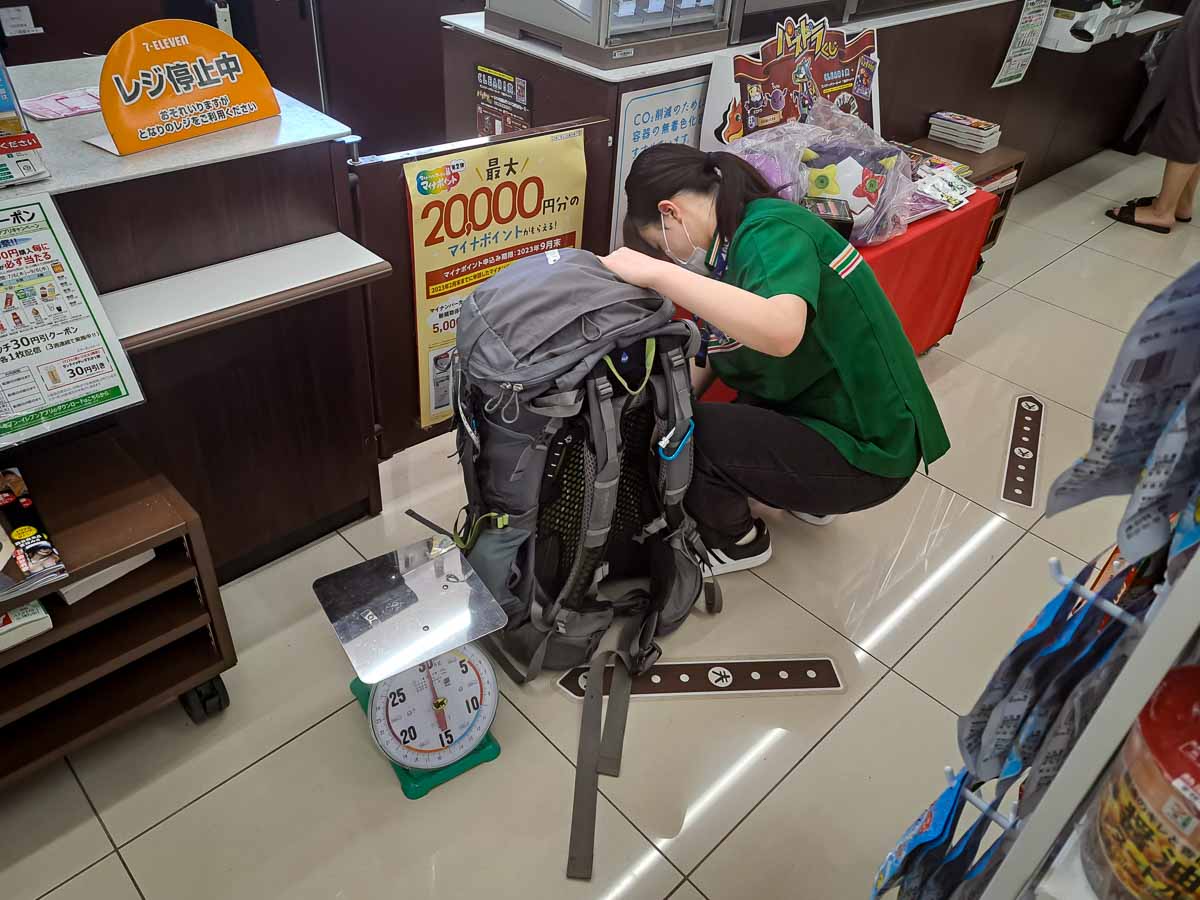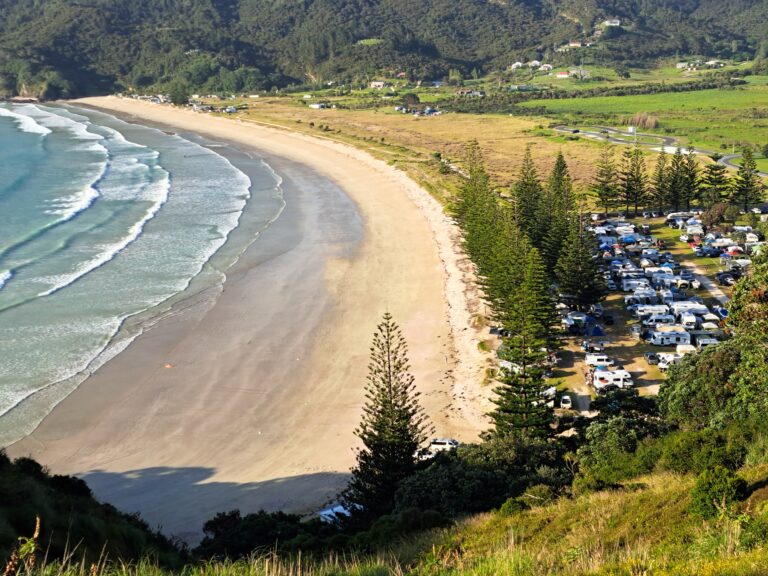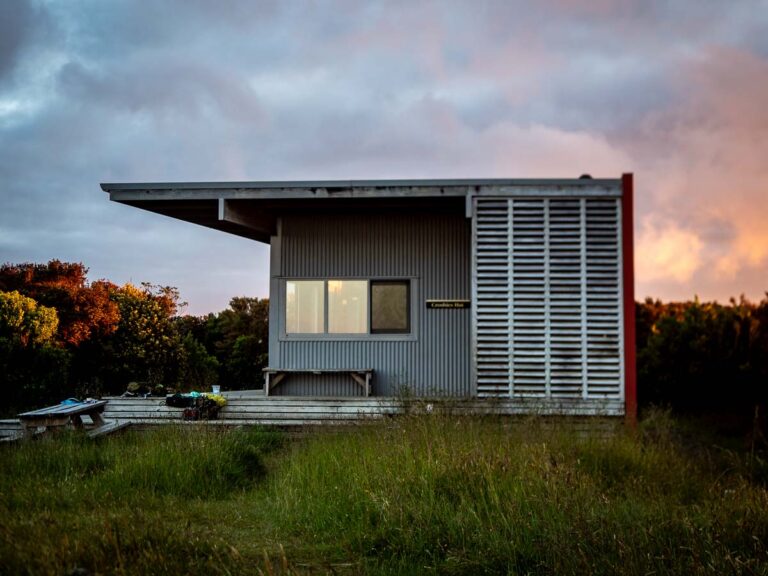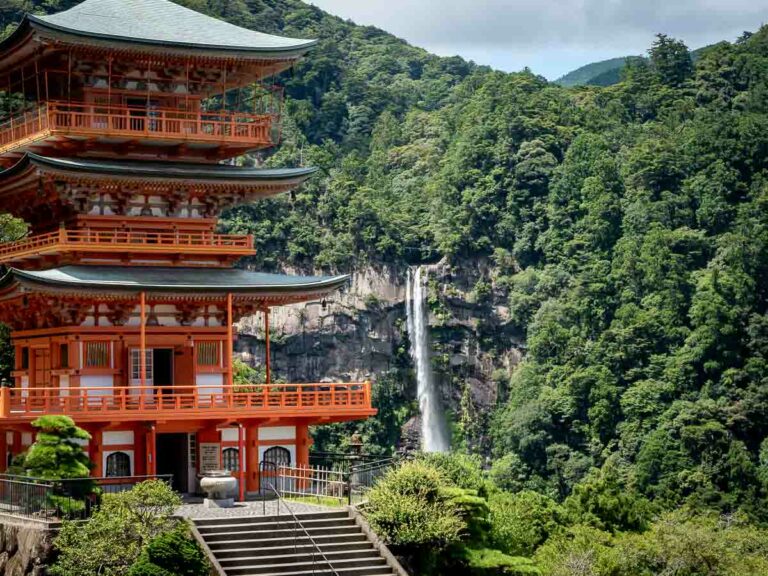Kumano Kodo Luggage Transfer Service (Key Info And Pricing)
Japan has everything on tap – from vending machines for cooked wagyu beef, to roaming robots that serve you sake.
Of course, they’ve figured out a way to make hiking easier too!
The Kumano Kodo is a World Heritage Site and one of Japan’s most popular pilgrimage trails, attracting thousands of visitors every year. And while absolutely stunning, you’ll still have over 70km of ground to cover, and 4000m+ of elevation to gain – It’s also not for the faint-hearted.
One way to lighten the load, and make the experience a whole lot more enjoyable is by using a luggage transfer service. Or, like we did, you can get your ‘rest of Japan’ luggage sent to the very end so you only carry what you need for the 4-6 days of hiking.
In this blog post, I’ll explain what Japan’s baggage transfer services are, how they work, and how to best use them to help you complete the Kumano Kodo.
Key Takeaways
Read More: You can read my complete guide to the Kumano Kodo here or check out some of my other detailed guides below.
Table of Contents

Kumano Kodo Trail Map
Celbrate your Kumano Kodo experience with this minimalist trail map of the Nakahechi Route (designed by me!) – showing all the key locations, start and end points, and trail stats at the bottom 🙂
Understanding How The Kumano Kodo Trail Works
The Kumano Kodo is a network of ancient pilgrimage trails that spans across the Kii Peninsula in Japan. It has been a UNESCO World Heritage Site since 2004 and attracts thousands of visitors every year.
The trail is divided into several routes, each with its own unique characteristics and attractions. The most popular routes are the Nakahechi, Kohechi, and Iseji.
- The Nakahechi route is the most well-known and takes hikers through beautiful forests, past waterfalls, and over mountain passes.
- The Kohechi route is more challenging and takes hikers through remote mountain villages and over rugged terrain.
- The Iseji route is less traveled and takes hikers along the coast and through small fishing villages.
Each route will take you through small towns along the way where you’ll find lodgings for the night. These are known as Ryokan (Japanese Ins) or Minshuka (Japanese guest house).
Even though you’ve been traversing mountains by foot, these towns are accessible by road and the luggage transfer service will drive in and drop off your belongings.
Do You Need A Luggage Transfer Service For The Kumano Kodo?
If you don’t want to cary your gear each day and would be more comfortable with a day pack you can opt for a luggage transfer service to take your bags to each destination ahead of time.
The Kumano Kodo is pretty hilly.
On the Nakahechi Route you’ll be doing over 4000m of elevation gain.
Thus, its a good idea to keep your backpack light.
That’s where using on of Japans famous luggage transfer services on the Kumano Kodo trail comes in.
With this service, you can have your luggage transported from one accommodation to the next, allowing you to fully enjoy your hike without the added burden of carrying heavy bags. \
Not only does the luggage transfer service lighten your load, but it also adds a level of convenience to your journey. You won’t have to worry about carrying extra clothes, toiletries, or any other bulky items. Instead, you can focus on the beautiful scenery and spiritual experience of the Kumano Kodo pilgrimage.
What I Did:
I hiked the Kumano Kodo in July 2023 and definitely underestimated the physicality of the trail. It was peak summer – circa 35 degrees – and the thought of carrying a full 70L hiking pack was not sounding like much fun.
We opted to have our ‘rest of Japan’ luggage taken from Tanabe (the start of the track) to Kii Katsura (The End). That way we only had to carry exactly what we needed for 5 days hiking and nothing more..
We then packed super light, only a couple of changes of clothes and the essential toiletries, camera, and phones, etc. We also left room for LOTS of water, and food and you’ll need to cary your lunch with you each day.
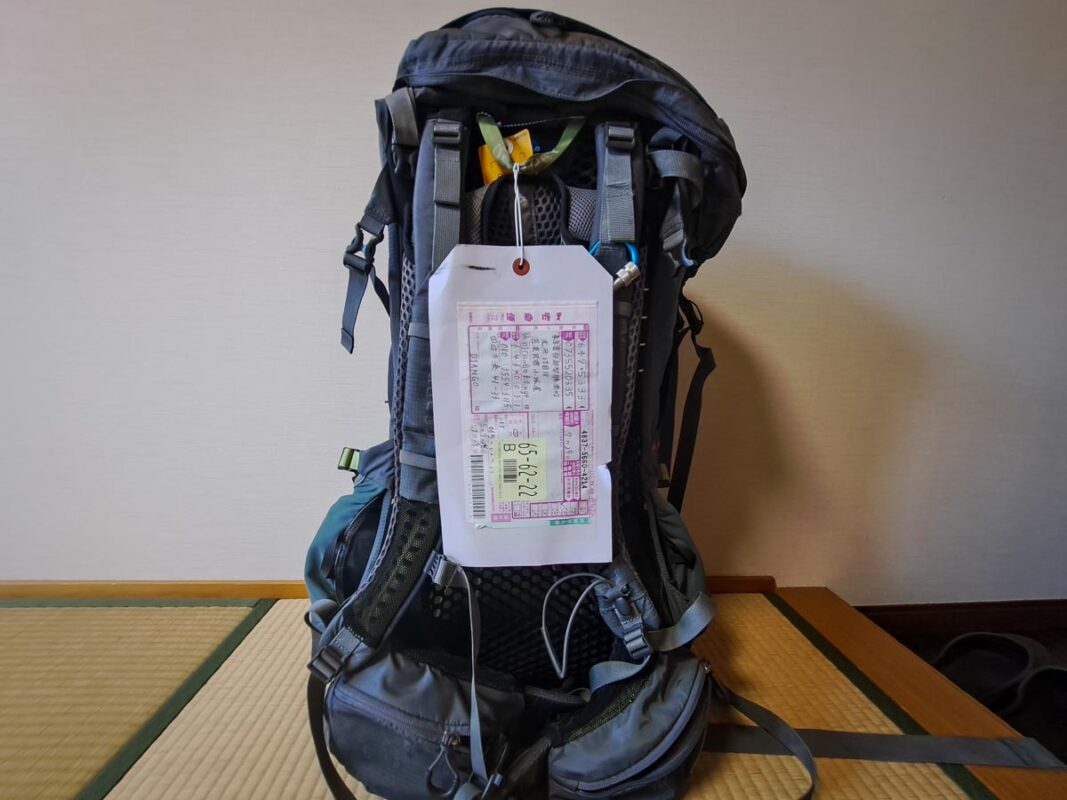
3 Kumano Kodo Luggage Transfer Options:
Option 1: Luggage Transfer Each Day
Let’s call this the luxury option. (though it’s actually pretty affordable).
You’ll get a bag sent from one accommodation to the next – so while you’re walking the bag will get dropped off in time for your arrival
This bag can have a fresh change of clothes, toiletries, computer, games, food – anything you may need in your downtime between arriving that day and setting off the next morning.
You’ll still need to carry a small back, but that only needs to contain water, your lunch, and maybe a rain jacket.
Super light!
Note: it is important to note that the luggage transfer service is not available at all accommodations on the trail. However, many of the major accommodations do offer this service, so be sure to check ahead of time and book in advance. Additionally, there may be weight and size restrictions for your luggage, so be sure to check with your accommodation or the luggage transfer service provider.
Option 2: Luggage Transfer To The End Of The Trail
This is what we ended up deciding on. We realized there was a bunch of stuff we needed for the rest of the trip (like nice clothes, a second pair of shoes, and souvenirs) that we definitely didn’t need to carry over a mountain range.
The obvious answer was to fill a bag with all these things and then get them sent to our final accommodation in Kii Katsura for when we finish the trail. We then packed two smaller hiking packs with our essentials like food, water, and hiking clothes, and evening clothes so you can have something clean to wear each night in the ryokan.
This ends up being a bigger bag than if you went with option 1.. but still a whole lot better than carrying your souvenir bottle of sake with you.
I’m a pretty stubborn ‘I’ll do it myself’ hiker but i was glad to have used the service – it’s too easy not to!
Read More: Checkout my recommended kumano kodo packing list in this article
Option 3: Leave your luggage in a Coin Locker at a central location
One option we were also considering was to leave the bag at one central location, like Osaka airport or Kii Tanabe station, and collect it on the way back.
FYI: Japan love their ‘coin lockers’. Almost every station has a bank of these, where you pay a small fee (from 300 – 700 yen typically) to have your belongings locked away for up to 3 days. (Note: you can extend this time period if you need).
For example. We were leaving for the Nakahetchi route from Kii Tanabe station. And coming home would involve taking the train back through Tanabe. We could jump off the train, grab our gear, and get on the next train back to Osaka.
You could also leave your bags in Osaka central if you’re heading back through there as theres hundreds of lockers availbile.
What’s The Best Kumano Kodo Luggage Transfer Service?
Here are some of the best Kumano Kodo luggage transfer services available:
What I used: I used the Yamoto service from the Kii Tanabe 7-Eleven. We rocked up on the morning we were leaving for the hike, paid about $15USD equivalent, and magically our bag turned up again 4 days later.
1. Kumano Kodo Luggage Shuttle Service
Recommendation: Best if you want daily luggage transfers to your next accommodation
The Kumano Kodo Luggage Shuttle Service is a convenient and reliable option for transporting your luggage along the Kumano Kodo trail. They offer daily luggage transportation between accommodations along the trail, so you can walk without the burden of heavy bags. You can book their service online or through your accommodation.
The Booking Process:
To use Kumano Travel’s transfer service, you need to book it at least 10 days in advance. You can book online through the website, or you can contact their customer service team for assistance. When booking, you will need to provide information such as the number of bags you want to transfer, your pickup and drop-off points, and your contact information.
Advantages:
The nice thing with Kumano Travel is everything can be done in English, unlike the other options where you’ll probably need to find someone to help you scribe out the forms in Japanese.
2. Yamato
Recommendation: Best if you want luggage transferred to the end of the trail, or you have made bookings outside of Kumano Travel
Yamato is also called “kuroneko” or “black cat” and can be spotted by the black cat on their vans. They are also available at convenience stores (Like Family Mart and 7-Eleven). .
Booking:
Simply turn up with your bag at a convenience store and staff will help you. No need to book – nice! The one catch is you’ll probably need help filling out the form as it’s in japanese (we got the owner of our hostel to assit!)
Note: They don’t offer a SAME DAY delivery service which means you’ll need to set your pack the night before – a bit of a pain if you want to send your sleepwear and toiletries too.
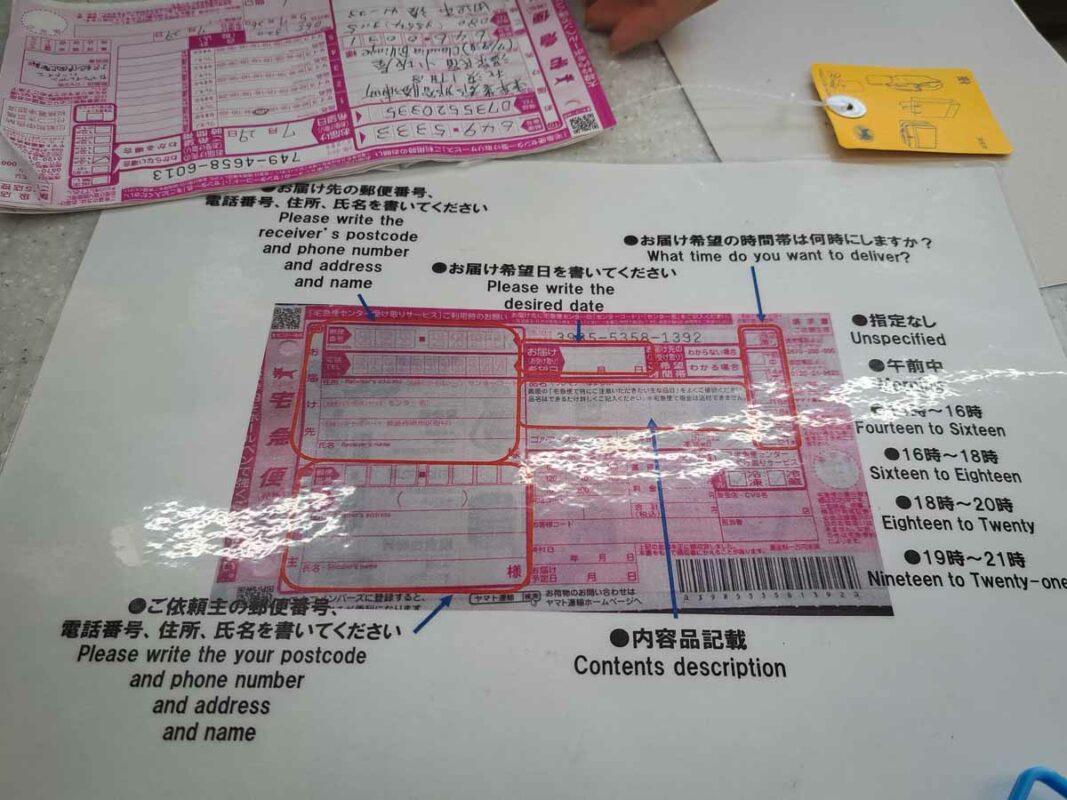
3. Oku Japan Luggage Transfer
Oku Japan offers a luggage transfer service for their Kumano Kodo tours. They will pick up your luggage from your accommodation each morning and transport it to your next destination. This service is available on their guided and self-guided tours, so you can choose the option that suits you best.
4. Takyubin Courier Service
Takyubin is a popular courier service in Japan that offers luggage transportation services. They have a convenient delivery system that allows you to send your luggage from your current accommodation to your next destination. You can book their service online or through your accommodation.
Overall, there are several reliable and convenient luggage transfer services available for the Kumano Kodo trail. By using one of these services, you can lighten your load and enjoy your hike to the fullest.
How Kumano Kodo Luggage Transfer Service Works
Right, so everything in Japan is kinda confusing – but also just seems to work.
Let me do my best to explain how exactly the luggage transfer services work
(BTW, we chucked an AirTag in our bag and followed its journey too.. but more on that later)
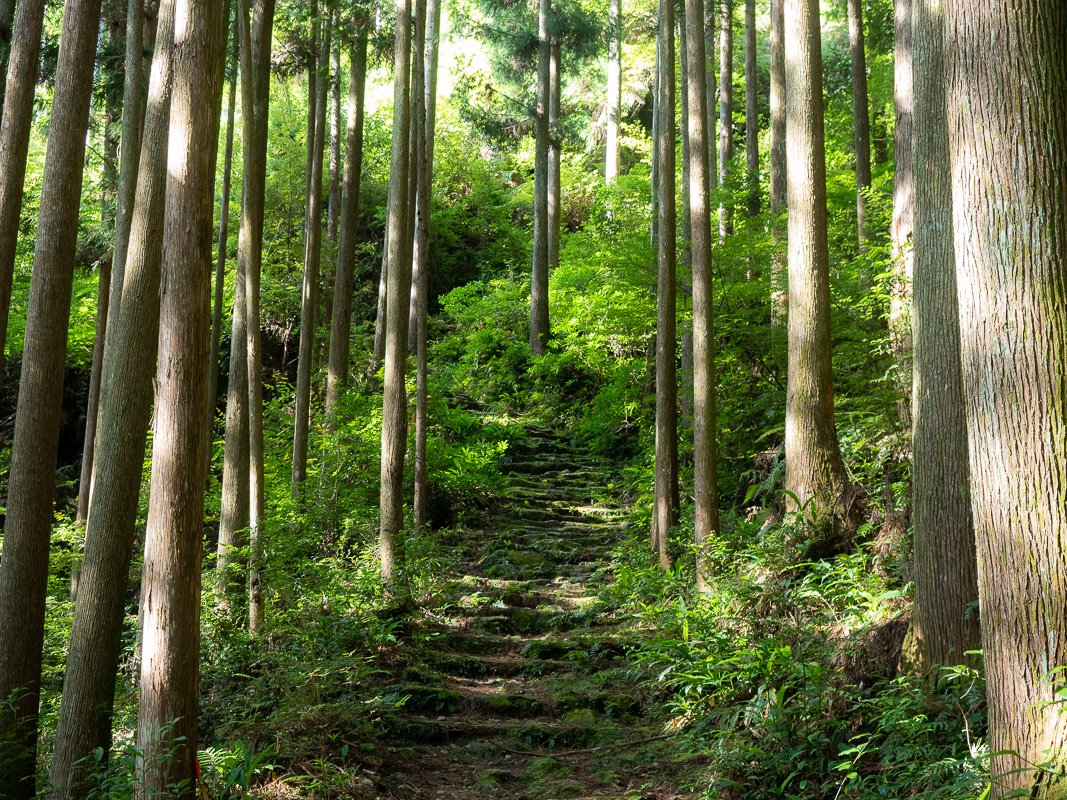
Benefits of Using Luggage Transfer Service
When embarking on a hiking trip along the Kumano Kodo trail, one of the most important things to consider is how to manage your luggage. That’s where the luggage transfer service comes in. Here are some benefits of using the luggage transfer service during your Kumano Kodo hike.
- Travel Light:
One of the main benefits of using the luggage transfer service is that it allows you to travel light. You can simply pack an overnight bag with your essentials and leave the rest of your luggage behind. This means you can enjoy your hike without being weighed down by heavy bags. With the luggage transfer service, you can have your bags transported directly to your accommodation, so you don’t have to worry about carrying them with you.
- Security:
Another benefit of using the luggage transfer service is that it provides added security for your belongings. When you entrust your luggage to a reputable transfer service, you can rest assured that your bags will be safely transported to your destination. This is especially important if you are carrying valuable items or important documents with you.
- Convenience:
Using the luggage transfer service also adds a level of convenience to your hiking trip. You don’t have to worry about lugging your bags around with you, which can be especially helpful if you are hiking for multiple days. With the luggage transfer service, you can have your bags transported directly to your accommodation, so you can focus on enjoying your hike and exploring the beautiful surroundings.
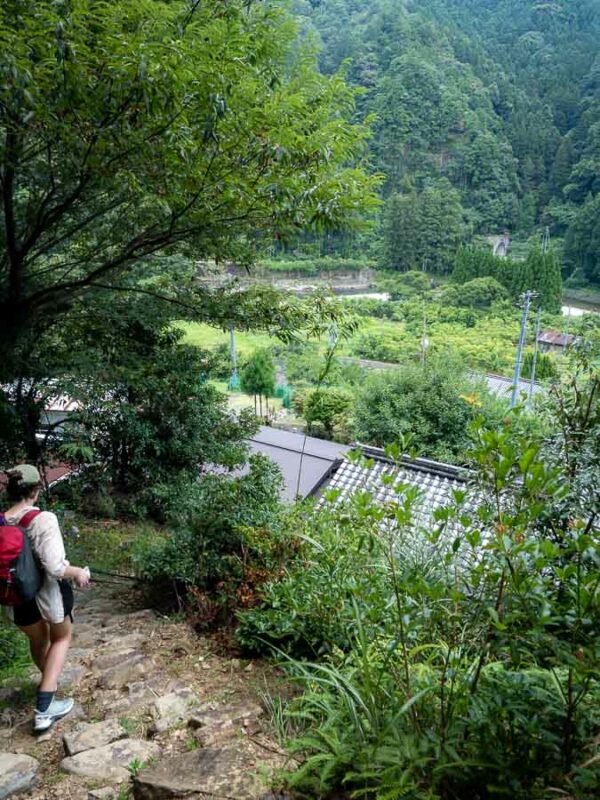
Cons Of Using The Luggage Transfer Service:
- Its A Lot Of Hassle and Admin:
I love the simplicity of living out of a day pack. You can choose between outfit A or B and you can always find what you’re looking for. IMO taking a full suitcase from stop to stop is not the way to do the Kumano Kodo. Plus, you’ll be spending valuable time packing and unpacking every day – time you could be out enjoying the walk. - The Costs Add Up:
IF we say on average the service costs $15 USD per bag per day you might be looking at ~$150 for 2 people doing a 5 day hike. Sure, that’s not the end of the world but it all ads up. We chose to fill one back with the stuff we didn’t need and get it sent to the end. That way it only cost us $15 for the whole trip!
Frequently Asked Questions
Q. What are some luggage transfer services available for the Kumano Kodo trail?
There are several luggage transfer services available for the Kumano Kodo trail. Some of the popular ones include Takkyubin, Yamato Transport, and Kumano Kodo Luggage Shuttle. These services allow hikers to send their luggage ahead to their next destination, so they can enjoy the trail without the burden of carrying their bags.
Q. How does Takkyubin’s luggage delivery service compare to Yamato’s for the Kumano Kodo trail?
Both Takkyubin and Yamato Transport offer reliable and efficient luggage delivery services for the Kumano Kodo trail. However, Takkyubin is generally considered to be more affordable, while Yamato Transport is known for its wider coverage area. It is recommended to compare the rates and coverage areas of both services before choosing one.
Q. Are there any discounts or promotions available for luggage transfer services on the Kumano Kodo trail?
Some luggage transfer services on the Kumano Kodo trail may offer discounts or promotions from time to time. It is recommended to check the websites or contact the services directly to inquire about any current deals or offers.
We found the cheapest and most convenient option was to simply go to a 7-Eleven and get them to take care of it.
Q. What is the process for forwarding luggage on the Nakasendo trail?
The process for forwarding luggage on the Nakasendo trail is similar to that of the Kumano Kodo trail. Hikers can use services such as Takkyubin or Yamato Transport to send their bags ahead to their next destination. It is recommended to research and compare different services based on individual needs and preferences.
Final Thoughts and Recommendations
Overall, using a luggage transfer service is a smart option for most poeple doing the Kumano Kodo trail. It allows you to fully immerse yourself in the pilgrimage experience without the added physical strain of carrying heavy bags.
If you’re tossing up whether to use the service or not, I’d say from my experience it was well worth while.
(even for a stoic like me, i conceeded this was a good idea!)
I’d recommend either going to a convenience store like 7-eleven and using the Yamato service on the day if you have time, or pre-booking your transfers with Kumano Travel (provided you’ve booked your accommodation through them).
Let me know in the comments below if you’ve used any of these services and what your experience was like.
Kumano Kodo Travel Planning Cheatsheet
🚑 Should I buy travel insurance for Japan?
100% YES! — Japan has “free” healthcare but it’s only for citizens! Tourists need travel insurance in case anything happens on your visit. Also be aware many policies won’t cover hiking as it’s a high risk activity! (that’s right, check the t&c’s on your complimentary credit card insurance)
I highly recommend World Nomads as you can get specific add-ons for the crazy activities you’re doing – and starts at just $7 a day!
🏩 What’s the best way to book my Kumano Kodo accommodation?
Your only realy two options here are Kumano Travel and Booking.com. Its a complicated process so I wrote this guide here on the best kumano kodo accomodation options
If you don’t want to figure it all out (it’s meant to be a holiday after all) you can book a package tour. Here are my recommendations for both guided and self-guided.
💸How do you pay for things in Japan?
Japan may have flying robots.. but they also still use cash! So you’ll want to get some folding tender out from an ATM when you land. EFTPOS / Debit / Credit Card and Paywave (contactless payments) is common at bigger businesses but small bars, and street vendors want cash.
I personally use a Wise debit card for all my international money needs as they only convert the funds when you make payment, plus they offer a much better spread (margin on the true exhange rate) than the banks do. They work in all Japanese ATMs I tried.
🚙 Do you need to rent a car in Japan?
I wouldn’t reccommend it — Transport in Japan is expensive whatever mode you chose, but fortunalty the publc transport system is out of this world in terms of both freqency and coverage. If you are heading to a lot of off the beaten track places, then you may want a rental. I use Discover Cars to find the cheapest rates on rentals cars and remember you can save money if you avoid picking up at the airport.
🚆 What about the JR Rail Pass?
We didn’t – but it depends on the length and itenirary of your trip. The JR Pass is expensive (and just went up in price again!) and if you’re walking the Kumano Kodo you wont need it for probably 6 days straight anyway.
Do the math, but in most cases buying the train fares you need, when you need it will work out more afforably overall – and give you more flexibility (as the JR Pass doesn’t cover all lines)
📲 How do I get internet/data/wifi in Japan and on the trail?
This one needs a whole nother article, but the short version is;
- local SIM cards are cheaper but generally require a fixed term contract (not practical for people visiting)
- Tourist ‘short stay’ SIMs are a bit more expensive but will give you plenty of data while your visiting and are best for solo travelllers.
- If you’re travelling as 2 or more people, renting a pocket WIFI unit from the airport is the most economical option – Works out cheaper than getting two tourists sims
- Use a travel eSIM like Saily or Airalo. This works from the moment you land is is SOOOOO much easier than trying to pick a data pack in japanese. It also gives you connectivity across neighbouring asian countries if you buy a regional sim! TIP: I used to use Airalo but now find Saily a much better product – you can get 5% off with code SPECIAL5
✈️ What’s the best site to buy flights to Japan?
For finding cheap flights, I recommend Skyscanner. Once you find the flight you’re looking for, I’d then suggest booking directly with the carrier (even if it costs a few $$ more than with one of the agreggators/agencies).
💧Can you drink the water on the Kumano Kodo?
Yes — Japan is very clean. In all townships you’ll pass through and stay along the Kumano Kodo the tap water is drinkable. If you want to drink water from the rivers and streams you generally can but should do so at your own risk. ALWAYS follow best practice and drink from fast flowing water as far up stream as possible. I drank the water and was fine.. but i’d generally recommend a Brita Water Bottle for rehydrating on the trail safely.
🎫 Do I need a visa for Japan?
Likely Not — Japan now recognises 70 countries as ‘visa exempt’ for short term stay. So if you’re a US, UK, NZ, AU and EU passport holder you don’t need a Japansese visas. However, some other countries do (check here!). And if you plan to stay for more than 90 days (an average tourist visa length), you will need to look into the Japanese working holiday visa scheme, or the new Digital Nomad visa scheme.

